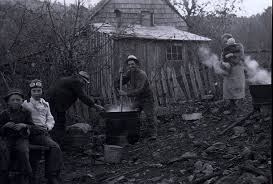The Good Housekeeping definition pretty much tells us – it’s the fat from pigs, cooked and used as shortening in several kinds of foods.
foods.
Few people use lard anymore, and the very mention often evokes unfavorable reactions – a shrug, a wan smile, or a wrinkled nose. Most cooks long ago replaced lard with more convenient substitutes or more healthy alternatives such as vegetable or olive oils. Today, this solid form of animal fat is saddled with a bad rap. Nutrition conscious eaters shun it for its devastating effects on our arteries; and though you can still buy preservative rich lard at the grocery, you’ll be hard pressed to find anyone who still supplies the fresh unprocessed version. Lard has become a four letter word. But for old time Smoky Mountain residents, lard was the grease that kept the wheels of life smoothly turning.
The manufacturing of real lard necessarily starts with butchering hogs. This was a time honored activity in the mountains, because nearly every farm had a few hogs. Pork, after all,, was the meat of choice of nearly every mountaineer. They left their pigs wander the woods most of the year, fattening up on chestnuts and acorns. After the first freeze in fall, usually sometime in November, they chose on or two the animals to butcher.
Usually on butchering day or the day after, the lard was rendered or melted. They cut it into small pieces about the size of a hen’s egg or smaller. These chunks were put into a big iron pot or wash kettle with just enough water to keep from sticking together, then simmered over a low fire. For those who might want a more accurate measure, one book says optimum temperature for thorough rendering should not exceed 255 degrees.
Lard had a few other hand uses around a farm other than cooking. Soap making was an important one. Wood ashes, preferably from hickory, were gathered in the hopper, and water was dripped through the ashes to produce lye. That was mixed with cold water and lard and cooked into a worthy “lye” soap. Lard had a few medicinal purposes too. Mixed with turpentine, it was rubbed on the chest to treat pneumonia.
Foods fall in and out of favor. Perhaps we moderns will someday again sing the praises of lard fresh from the pig. Maybe, just maybe…or maybe not!
